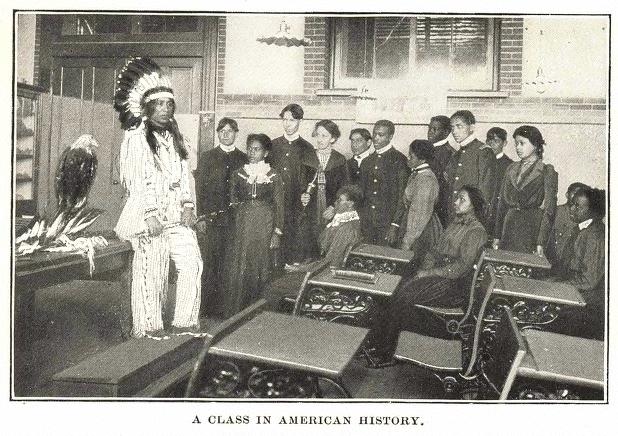|

(c) Pocumtuck Valley Memorial Association, Deerfield MA. All rights reserved.
Two Worlds : Moving Between Worlds
|
|
American westward expansion and settlement continued to devastate Native societies and economies. In the west, settlers, speculators and the United States government dispossessed Native people of millions of acres of traditional homelands and vital resources. Poverty, disease, despair and alcoholism took a heavy toll among those forced onto small reservations. By the 1880s, American reformers were drawing attention to the plight of the Native peoples of the west. Speeches, letters and books like Helen Hunt Jackson's A Century of Dishonor informed readers of the poor treatment Indians had received at the hands of the United States government. Most humanitarians believed that the only way to ensure the survival of Native Americans was to educate and assimilate them into white culture and society. Children and young people, reformers reasoned, would be most likely to assimilate successfully. The main vehicle in this process was the boarding school. Such schools endeavored not only to educate but also to indoctrinate students in white culture and society. Their goal was, as the founder of the Carlisle School in Pennsylvania put it, to "kill the Indian, save the man."
The best intentions of their founders and supporters notwithstanding, these schools witnessed scenes of incalculable misery. Dozens of schools housed thousands of bewildered and desperately homesick children wrenched not only from their families but from their cultures, as well. Many fell victim to dangerous illnesses and died. Those who returned home struggled to reconcile their boarding school education and experiences with reservation life and culture. Others were cut permanently adrift from their families and heritage. The most successful students adapted and integrated elements of white society and education into their own languages, beliefs and traditions.
The Hampton Institute in Virginia was founded in 1868 to educate freedmen after the Civil War. It began admitting Native American students in 1878. According to a report published in 1901, its purpose was "to train academic and industrial teachers for the Indian and Negro races, and to fit young men and women to become skilled craftsmen. Much stress is laid upon land-buying, home-life, and agricultural pursuits." Like those attending similar institutions, Hampton students faced the difficult challenge of acclimating to a new culture, language and expectations.
top of page
|
"Learning By Doing At Hampton"
| creator American Monthly Review |
| date 1900 |
| location New York |
| process/materials printed paper, ink |
| item type Books/Booklet |
| accession # #L01.005.06ex |
|





